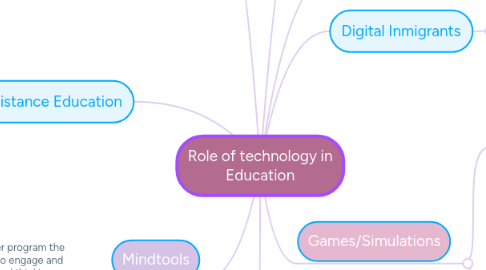
1. Technology in the classroom
1.1. issues
1.1.1. Fees
1.1.2. Learners without technology
1.1.3. Abuse of technology
1.1.4. Cyber stalking
1.1.5. Obsolescence of any technology
1.2. Do not teach
1.2.1. Is how it is used
1.2.1.1. Learning is achieved
2. Mindtools
2.1. Any computer program the learner uses to engage and facilitate critical thinking
2.1.1. Learners use them to
2.1.1.1. Organize
2.1.1.2. Restructure
2.1.1.3. Represent
3. Distance Education
3.1. uses 100% technology
3.1.1. Used for facilitation and not eduaction
3.2. Materials can become
3.2.1. Outdated
3.2.2. irrelevant
3.2.3. broken
4. Learning Community
4.1. Factory model
4.1.1. Do not open doors to the future
4.1.2. Imprison students in their own minds
4.2. Schools have to change
4.2.1. reasons
4.2.1.1. Web learning
4.2.1.2. ICT
4.2.1.3. Home (Learning place)
4.2.1.4. Digital Natives learn from technology
4.2.1.5. Workers require upgrading
4.3. Learners choose what and how they will learn
4.4. Model
4.4.1. Elementary
4.4.1.1. basic reading and writing, math and science
4.4.2. Secondary
4.4.2.1. students became self-directed
4.4.2.2. Learning contract
4.4.2.2.1. Signed by students, teachers and parents
4.5. Students can take advantage of social constructivism
4.6. Self-Directed Learning (SDL)
5. Learning
5.1. tenets
5.1.1. Meaningful
5.1.2. Knowledge and skills
5.1.3. far transfer
5.1.4. Cognitive load
5.2. The greater the correlation, the easier the assimilation
5.2.1. The learner's expertise
5.2.2. Learning
5.3. Constructivists
5.3.1. knowledge cannot be transferred
6. Digital Natives
6.1. Have spent their entire lives surrounded by toys and tools of the digital age
7. Digital Inmigrants
7.1. Grew up before the digital age
7.2. Have adapted to technology
8. Games/Simulations
8.1. Digital Games
8.1.1. Mini-games
8.1.1.1. Recreational
8.1.1.2. Educational
8.1.2. Complex games
8.1.2.1. Outside research
8.1.2.2. Collaboration with others
8.1.3. Problem
8.1.3.1. Designed a good game around specific subject matter is really difficult
8.1.3.2. Cover a full course curriculum
8.2. Silumations
8.2.1. Should be used with
8.2.1.1. some scaffolding
8.2.2. It is a game
8.2.3. Attempts to model asomething in the real world
8.2.4. Are based upon the experience/ requirements of the developers
8.2.4.1. The quality may be poor
8.2.4.2. The funcionality may be incorrect or advanced
